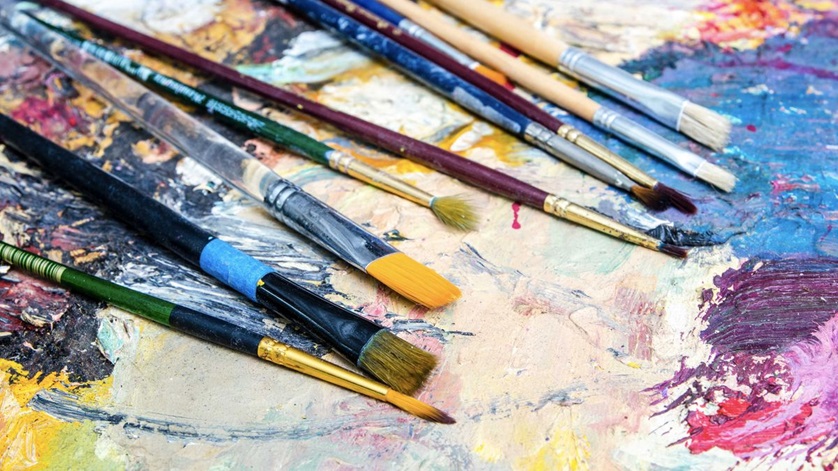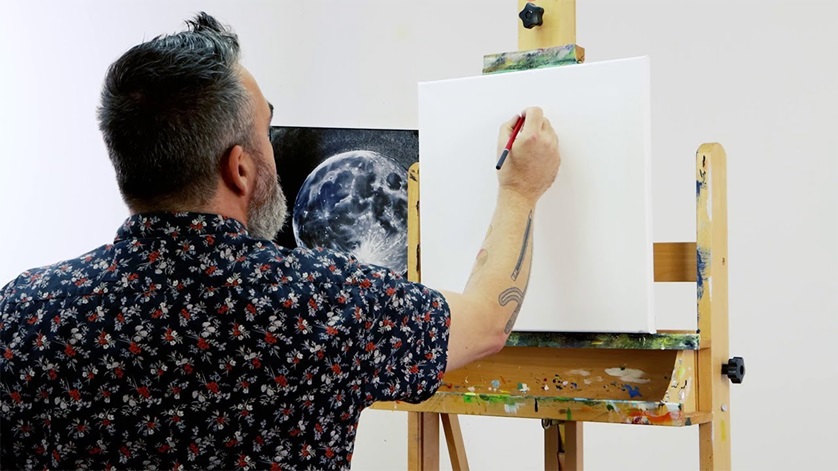Building your acrylic painting arsenal is an exciting step in your artistic journey, and choosing the right supplies can greatly enhance your creative process. Whether you’re a beginner venturing into the colourful realm of acrylics or an experienced artist seeking to upgrade your toolkit, choosing the right tools is key to unlocking your full potential. From paints and brushes to palettes and canvases, gathering these essentials lays the foundation for your artistic exploration and learning.
Contents
Brushes

Acrylic paint brushes come in various shapes, sizes, and materials, each influencing the painting technique and outcome. When considering brushes, factors such as shape, bristle type, and handle affect the paint application, texture, and overall control.
Different brush shapes offer varied effects. Flat brushes enable broad strokes and precise edges, suitable for washes or bold lines. Round brushes are versatile, allowing detail work, fine lines, and broader strokes. Filbert brushes combine aspects of both, useful for blending, soft edges, and detailing. Angular brushes assist in precise strokes and corners, making them ideal for architectural or angular shapes.
Quality brushes ensure better paint application and durability. That said, look for well-constructed acrylic paint brushes with tightly packed bristles, avoiding shedding or splaying during use. Assess the bristle’s resilience and springiness, ensuring they return to their original shape after use.
Moreover, brushes are either made from natural or synthetic bristles. Natural bristles are robust and work well with heavier paint, ideal for textured effects. Synthetic bristles, usually made of nylon or polyester, are more flexible and durable, suitable for smoother applications and precise details. Another aspect to consider is their handle. Brush handles vary in length and material. Longer handles provide more reach and leverage, ideal for larger canvases. On the other hand, shorter handles offer more control, making them suitable for intricate details or working up close.
Before selecting acrylic paintbrushes you need to consider your preferences and your painting style. A basic set might include a variety of shapes and sizes: a couple of flat and round brushes in different sizes can be versatile for beginners. As your skills advance, you can invest in specialised brushes or specific shapes for certain techniques.
It’s important to point out that proper care prolongs brush lifespan. That said, make sure you clean your brushes immediately after using them with mild soap and water, reshaping the bristles before drying to retain their original form. Store the brushes flat or hanging to protect their shape and quality.
Acrylic Paint
When starting with painting, opt for a basic set of primary colours alongside white, offering a versatile palette for experimentation. Begin with small quantities to explore colour mixing and application techniques. Dilute acrylics with water for a watercolour-like effect or use them directly for bold strokes. Embrace layers: allow each coat to dry before adding subsequent ones to avoid muddying colours. You can also experiment with various surfaces like canvas, paper, and wood to understand how acrylics interact.
Palette and Knife
The palette knife, a versatile tool in acrylic painting, aids in mixing, applying paint, and creating textured effects. When choosing a palette knife, consider the blade’s flexibility, size, and shape. Flexible blades allow better paint manipulation, while various shapes offer different textures and strokes. Stainless steel or tempered steel knives are durable choices.
For palettes, opt for materials like glass, wood, or acrylic, providing a smooth mixing surface. Wooden palettes are traditional but require more cleaning, while glass or acrylic ones are easier to maintain. Ultimately, the best palette knife and surface depend on personal preferences and the desired painting techniques.
Canvas and Easel

When painting with acrylics, consider the canvas that best suits your needs. Opt for primed canvases, typically stretched over a wooden frame, like cotton or linen, offering a sturdy surface for paint adhesion. Beginners may find pre-primed canvases convenient, reducing preparation time. The acrylic paper provides ease and flexibility for experimentation.
While an easel can enhance your comfort and control, it’s not a mandatory tool. You can work on a flat surface or use a tabletop easel, as it aligns with your preferences. The type of canvas you select—be it stretched canvases, canvas boards, or paper— should align with your artistic objectives and comfort. As for an easel, its requirement depends on your working style and personal preferences, varying from artist to artist.Water ContainerSelecting a water container for acrylic painting is crucial. Opt for a container that suits your preferences and workflow, prioritising functionality and convenience. A wide-mouthed jar or a plastic container works well, providing ample space for brush cleaning.
Ensure it is sturdy and spacious enough to hold water for rinsing brushes effectively. Personalise your choice based on convenience—consider a container with sections if you use various water consistencies while painting. Don’t forget to replace the water regularly to maintain cleanliness and prevent colours from mixing unintentionally.
Mediums and Additives
In acrylic painting, you can choose to use mediums and additives to enhance your artwork. While not mandatory, they give you control over how your paint behaves and the textures you can create. For instance, gel mediums help adjust paint thickness and transparency, allowing you to create thick textures or transparent layers.
Texture pastes let you add raised elements or intricate textures to your paintings. Retarders slow down drying times, useful for blending colours or working on larger projects. These options expand your creative possibilities, allowing you to experiment with different effects and techniques, adding depth and uniqueness to your acrylic paintings. Whether you decide to use them or not depends solely on you and your creative needs.
Varnish
Varnish in acrylic painting serves as a protective and enhancing layer for finished artworks. Applied on top of fully dried acrylic paintings, varnish shields the surface from dust, UV rays, and minor abrasions, preserving colours and longevity. It also offers a uniform finish, enhancing vibrancy, and intensifying colour depth, giving paintings a professional sheen.
Matte varnishes reduce glare, while gloss varnishes amplify richness. Application methods can vary and typically require a well-ventilated space. While optional, varnishing not only protects but also enriches the visual impact of acrylic paintings, ensuring their durability and showcasing their colours in full glory.
How Can I Be a Good Acrylic Painter?
Becoming skilled in acrylic painting involves learning and practising consistently. Start by understanding the basics: know how colours work together, handle brushes well, and learn about layering paint. Practice regularly, trying out different surfaces and painting styles to find what you enjoy.
If possible, try to invest in good-quality paint, tools and supplies. Take time to learn some tricks from experienced artists and welcome feedback graciously. Ensure you stay dedicated, learn from your mistakes, and enjoy the journey of improvement and creativity.











